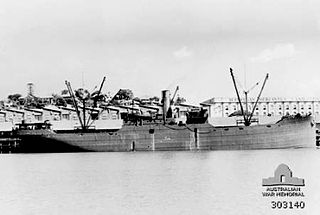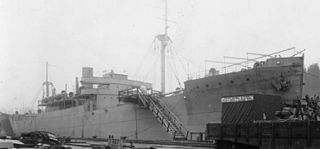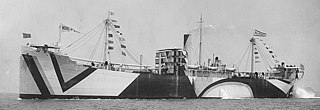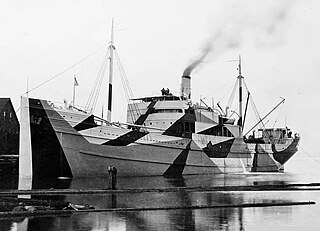
SS West Hosokie was a steel–hulled cargo ship built in 1918 as part of the World War I emergency wartime shipbuilding program organized by the United States Shipping Board.

The Skinner & Eddy Corporation, commonly known as Skinner & Eddy, was a Seattle, Washington-based shipbuilding corporation that existed from 1916 to 1923. The yard is notable for completing more ships for the United States war effort during World War I than any other West Coast shipyard, and also for breaking world production speed records for individual ship construction.
West Mingo was a Design 1013 cargo ship built in 1919 by the Los Angeles Shipbuilding & Dry Dock Co of Los Angeles. She was one of many ships built by the company for the United States Shipping Board.

Belorussia-class cargo ships were a Soviet Union class of 25 cargo ships which were built on the West Coast of the United States as per Design 1013 ship and as per Lend-Lease Agreement purchased by USSR in 1942–1945 years, during World War II, as the USSR needed ships of the merchant fleet during World War II and in the first years after this war. Sometimes this class of the ships in USSR marked as West-class cargo ships due to all ships were built on the West Coast of US.

The Design 1023 ship was a steel-hulled cargo ship design approved for mass production by the United States Shipping Board's (USSB) Emergency Fleet Corporation (EFC) in World War I. Like many of the early designs approved by the EFC, the Design 1023 did not originate with the EFC itself but was based on an existing cargo ship designed by Theodore E. Ferris for the United States Shipping Board (USSB). The ships, to be built by the Submarine Boat Corporation of Newark, New Jersey, were the first to be constructed under a standardized production system worked out by Ferris and approved by the USSB.
The Design 1017 ship was a steel-hulled cargo ship design approved for production by the United States Shipping Board's Emergency Fleet Corporation (EFT) in World War I. They were referred to as the "Downey-type" as they were built by Downey Shipbuilding on Staten Island. 10 ships were completed for the USSB in late 1918 and through 1919. An additional ship was completed in 1920 for a private shipping company.
The Design 1018 ship was a steel-hulled cargo ship design approved for production by the United States Shipping Board's Emergency Fleet Corporation (EFT) in World War I. They were referred to as the "Sun-type" as they were built by Sun Shipbuilding & Drydock Co. in Chester, Pennsylvania. 4 ships were completed for the USSB in late 1919 and through 1920. An additional ship was completed in 1920 for a private shipping company.

The Design 1019 ship was a steel-hulled cargo ship design approved for mass production by the United States Shipping Board's Emergency Fleet Corporation (EFT) in World War I.
The Design 1012 ship was a steel-hulled cargo ship design approved for production by the United States Shipping Board's Emergency Fleet Corporation (EFT) in World War I. They were referred to as the "Munrio"-type which was the name of the SS Munrio, a similar pre-EFT ship built at the Bethlehem Sparrows Point Shipyard.

The Design 1014 ship was a steel-hulled cargo ship design approved for production by the United States Shipping Board's Emergency Fleet Corporation (EFT) in World War I. They were referred to as the "Cascade"-type. They were all built by Todd Drydock and Construction Company, at their Tacoma, Washington shipyard. 20 ships were completed for the USSB in 1919 and 1920; and additional 2 were completed in 1920 for private companies. 12 ships were cancelled.

The Design 1015 ship was a steel-hulled cargo ship design approved for production by the United States Shipping Board's Emergency Fleet Corporation (EFT) during World War I. They were referred to as the "Moore & Scott"-type.
SSCambridge was a Design 1023 cargo ship built for the United States Shipping Board immediately after World War I.

The Design 1029 ship was a steel-hulled passenger/cargo ship designed to be converted in times of war to a troopship. design approved for production by the United States Shipping Board's Emergency Fleet Corporation (EFT) in World War I. They were referred to as the 535-type as all the ships were 535 feet overall length. A total of 11 ships were built from 1921 to 1922. Three shipyards built the ships: Bethlehem Sparrows Point Shipyard of Baltimore, Maryland ; Newport News Shipbuilding & Drydock Company of Newport News, Virginia ; and New York Shipbuilding Company of Camden, New Jersey.
The Design 1038 ship was a steel-hulled tanker ship design approved for production by the United States Shipping Board's Emergency Fleet Corporation (EFT) in World War I. A total of 16 ships were ordered of which 8 were cancelled and 8 completed from 1919 to 1920. The ships were constructed at the Mobile, Alabama shipyard of the Mobile Shipbuilding Company.
The Design 1041 ship was a steel-hulled tanker ship design approved for production by the United States Shipping Board's Emergency Fleet Corporation (EFT) in World War I. A total of 13 ships were ordered and completed for the USSB from 1919 to 1920. The ships were constructed at the Oakland, California shipyard of Moore Shipbuilding Company. An additional 5 ships were completed separately by the shipyard.

The Design 1065 ship was a wooden-hulled cargo ship design approved for production by the United States Shipping Board's Emergency Fleet Corporation (EFT) in World War I. A total of 7 ships were ordered and completed for the USSB from 1918 to 1919. The ships were constructed at the Bellingham, Washington shipyard of Pacific American Fisheries. The USSB originally wanted Pacific American Fisheries to follow its standard "Ferris-type" design used by other shipyards but PAF was successful in convincing them to use their own design which they felt was more seaworthy. The cost was $50,000 per ship.
The Design 1004 ship was a wood-hulled cargo ship design approved for production by the United States Shipping Board's Emergency Fleet Corporation (EFT) in World War I. They were referred to as the "Peninsula"-type as all were built by the Peninsula Shipbuilding Company in Portland, Oregon. All ships were completed in 1918 or 1919. Ten ships were completed. The "Peninsula"-type were the only wooden-hull ships built with a turbine engine which was common on steel ships built at the same time.
The George F. Rodgers Shipbuilding Company was a shipbuilder located in Astoria, Oregon.
The Design 1005 ship was a wood-hulled cargo ship design approved for production by the United States Shipping Board's Emergency Fleet Corporation (EFT) in World War I. The ships were referred to as the "Grays Harbor"-type as all were built by the Grays Harbor Motorship Company in Aberdeen, Washington or the "Ward"-type after their designer M. R. Ward. The first ship of the class, the SS Wishkah, was listed at 2,924 gross tons with dimensions of 272.1 x 48.4 x 25.7, 1400 indicated horsepower, and carried a crew of 47. The class does not include the four Design 1116 cargo ships also designed by Ward and completed at the shipyard as they were a modified design at 3,132 gross tons and 5,000 tons deadweight. All ships were completed in 1918 or 1919.
The Design 1016 ship was a wood-hulled cargo ship design approved for production by the United States Shipping Board's Emergency Fleet Corporation (EFT) in World War I. As part of a larger effort to rapidly increase the country's shipping capacity, the EFT approved several standardized ship designs, including the Design 1016, which was intended to be easy to build and maintain, and to have a large cargo capacity.









